Live Design
Udder Simplicity
by David Johnson on September 1, 2002
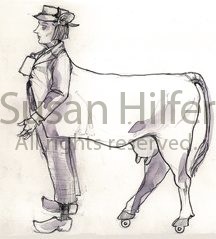
Sketch #1 for “Milky” for Into the Woods. Sketch and design by Susan Hilferty.
The process of taking an initial idea to final design can be a long but fascinating journey. To bring life to Milky-Cow for the Broadway revival of Into the Woods (the animal was little more than a prop in the original production, but is being played by a live actor in the new version), costume designer Susan Hilferty created a wide-ranging series of sketches focusing on different aspects of the character before settling on the one that worked best with the production. Here she offers us a glimpse into such a process:
“All the initial goals with the cow were to find a level of humanness, and then to find a level of character,” she says. Sketches 1 and 2 show Milky-White as “clearly a cow, but dressed, where you’re not seeing the body of the cow. This was trying to find the balance between what might become confusing: Is the expectation that she can sing if we see her mouth? Will it be too sad when the cow dies?
-
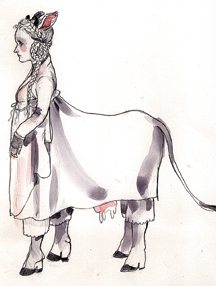
Sketch #2 for “Milky” for Into the Woods. Sketch and design by Susan Hilferty. -
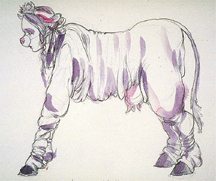
Sketch #3 for “Milky” for Into the Woods. Sketch and design by Susan Hilferty.
“What happens, then, if you take a girl and make it more cowlike, giving it a cow nose and ears [Sketch 3]? What was great about this was the suspension of disbelief: Would you believe it was a cow, even though it was just a little cow nose stuck on somebody’s face? And then we started to play with the idea of what happens when you sensualize it even more, which brings us to what I call my lesbian cows [Sketch 4]. In all these, you knew it was an actor playing a role, which was something we never lost. Then we tried it personalized, but with a cow head and a cow body [Sketch 5]. These are all about, can you have a human with some of the accouterments of a cow, and can it be believable [Sketch 6]? Ultimately, the biggest question of this route is, is it magical enough? And is it scary for kids, or weird for kids? You have to worry about what might frighten them.
-
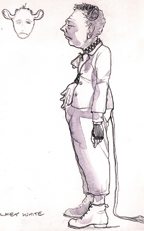
Sketch #4 for “Milky” for Into the Woods. Sketch and design by Susan Hilferty. -
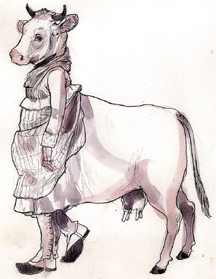
Sketch #5 for “Milky” for Into the Woods. Sketch and design by Susan Hilferty.
“Then we had to say, wait, this is all getting too complicated. Let’s just talk about making a cow. When we started talking about how the cow was going to move, and the relationship of the cow to the whole piece, that’s what broke it — something that was physical, something that you knew there was a human inside it. And from there, we focused on the personality. I played with the idea of not making it too realistic, like a stuffed animal, that kind of simplicity [Sketches 7 and 8]. It became important that the head was low, because that made it sadder and sweeter. And that’s ultimately where you get to the final sketch, using humanness in the face, and the eyes, which have nothing to do with a cow. I knew this was the one.”
-
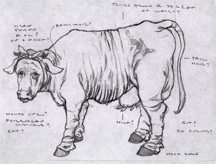
Sketch #7 for “Milky” for Into the Woods. Sketch and design by Susan Hilferty. -
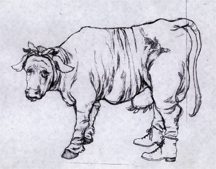
Sketch #6 for “Milky” for Into the Woods. Sketch and design by Susan Hilferty.